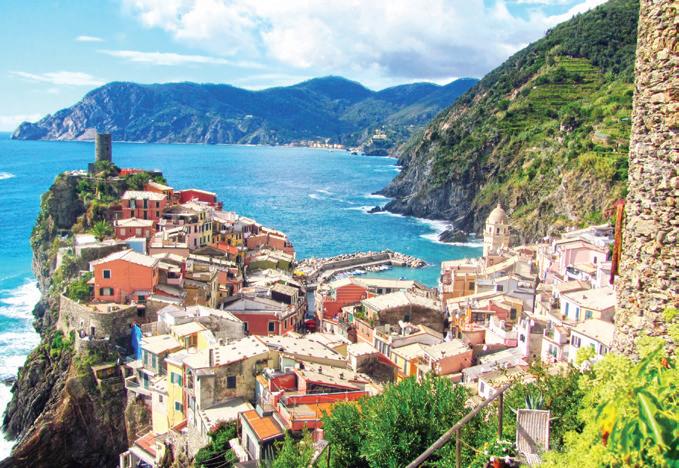


AN OWENSBORO GATHERING | ATLANTA CONNECTIONS | AUTHENTIC WINE ENCOUNTERS





AN OWENSBORO GATHERING | ATLANTA CONNECTIONS | AUTHENTIC WINE ENCOUNTERS







any of you may read Thrillist, a travel media website that has become a leading resource for younger demographics like Gen Zs and millennials. It offers in-depth reviews of cities and regions throughout the world and gives practical advice for finding authentic experiences, nightlife, events and cuisine. It does a great job of offering readers ideas about how to enjoy more than just a destination’s bestknown sites or activities.
Thrillist recently published a fascinating article about the growth of guided tours worldwide and how younger travelers are using them. It turns out these budding world travelers are not turned off by taking a guided tour at all — quite the opposite.
The article explored research created by Get Your Guide, a leading booking platform for sightseeing guide services. That research found that 80% or
more of millennials and Gen Z travelers are likely to book a sightseeing guide in the coming year.
Leave it to 20- and 30-somethings to make such tours cool again. That means it’s also cool for those of us who have done walking tours in cities like Budapest or Vienna to recommend them to our children — or our children’s children.
To be clear, this is not drive-by stuff. These are small group walking tours that help to define a city or locale. Expert commentary about local architecture, delicacies, beverages, markets or music are just a few of the street-level insights young travelers are seeking on guided tours.
So in this regard, the more travel changes, the more it stays the same. As many of you know from experience, a superb local guide in a city far away may be who provides the highlight of your group’s next trip.
To read the Thrillist article, visit thrillist.com
Mac Lacy — Publisher
Email me anytime with your thoughts at maclacy@grouptravelleader.com.
We’re pleased to introduce our new advertising sales manager for Select Traveler magazine, Telisa Rech! Telisa works with our vice president of sales and marketing, Kyle Anderson, and comes to us from previous sales positions in the coffee and lottery industries. She is a successful travel agent as well. She has made travel arrangements for dozens of clients and small groups over the years and joins us with a lot of practical knowledge about upscale travel for small groups.
Telisa lives just outside Lexington in Nicholasville, Kentucky, with her two dogs, Smokey and Bandit. Contact Telisa today about your advertising needs for Select Traveler magazine — including print and digital advertising; Gather and Go podcast sponsorships; OnSite familiarization trips with our travel planners; custom content; and other services we provide to destinations just like yours.
Welcome, Telisa!


BY VICKIE MITCHELL
Groups have lots of options for gaming trips, but only in Atlantic City can they play the slots in a string of casino resorts that sit on the sand next to the sea.
“Nowhere else in the U.S. can you find this,” points out Heather Colache with Visit Atlantic City.
Six of the city’s nine casino resorts welcome motorcoaches, each with its own style and amenities. The friendliness extends to the motorcoaches that bring groups into town; each of the six offers on-site motorcoach parking.
Although massive casinos are the biggest draw for these resorts, the entertainment doesn’t stop there. Each has restaurants and bars, sometimes numbering in the double digits, plus spas, fitness centers, shops, pools and live entertainment ranging from Broadway style shows and comedians to big-name singers and bands. And there’s always more fun just steps away from the properties, along the famous five-mile-long Boardwalk.
Partly due to its central location on the Boardwalk, the 942-room Resorts Casino Hotel is a group favorite. It was the first casino to open in Atlantic City in 1978. At Resorts, happy hours pop up everywhere, including the LandShark Bar and Grill, Atlantic City’s only year-round beach bar.
In business nearly as long is the 1,200-room Bally’s Atlantic City, which celebrated its 45th year in 2024 by opening a new steakhouse, a VIP players’ lounge, a high-limit slots room and a 24-seat carousel bar. It’s spent $100 million on guest room renovations and a new venue called The Yard, where gastro pub foods pair with local brews and an arcade, lawn games and music entertain.
The Tropicana Atlantic City lives up to its lively name with 15 restaurants that stretch across cultures, from Cuba Libre to Carmine’s to Ossu Asian Tavern. Laughter echoes from its nightclub on comedy nights; a 2,000-seat theater stages Broadway-style shows. Four pools and the Breath Salt Spa offer respite from the action.
Speaking of pools, each night a DJ plays tunes to inspire dancing and other fun at The Pool at Harrah’s Atlantic City. It’s just one of many options at Harrah’s, which has 10 bars and 13 restaurants.
The biggest new show in town is Spiegelworld’s The Hook, a humorous homage to Atlantic City’s golden age of live entertainment. At the 1,144-room Caesars, in the restored Warner Theater, it’s an adults-only show with everything from acrobatic acts to a chorus line of lobsters.
For something off the bustling Boardwalk, there’s the Golden Nugget, which, like Harrah’s, is at the Marina. The resort casino has been busy renovating its 700 rooms, its Chart House restaurant and has opened a Mexican restaurant, Dos Caminos.
Even with so much to do at the casinos, no one can resist Atlantic City’s many other temptations: strolls on the Boardwalk, afternoons beneath an umbrella on the beach, an evening boat ride to take in the sunset, a stop in the dozens of local shops and restaurants. In terms of a trip that will be memorable, Atlantic City celebrates any occasion.



WITH LISA PASSLEY
Vice President and Director of Lifestyles
CARTHAGE, MISSOURI
Southwest Missouri Bank was founded in 1979 and is the largest locally owned community bank in southwest Missouri. The first branch opened in Carthage, followed by branches in Joplin, Neosho, Jasper and Alba. There are now 11 full-service branches. Lifestyles is the bank’s checking account with affinity travel benefits for its customers aged 50 and above.
BIRTHPLACE: Webb City, Missouri
EDUCATION: Alba High School class of 1981, one year of college at Missouri Southern University
EMPLOYMENT HISTORY:
• Southwest Missouri Bank, 1997–present
• JCPenney 1987–1997
FAMILY: Passley has been married to her husband, Danny, for 43 years. They have two daughters, Lacey and Anna, and a granddog named Prudence June.
HOBBIES: Passley loves spending time with her family, traveling and relaxing at the lake.


Lisa Passley has led the Lifestyles travel program to places like the FDR Presidential Library (left) and the 150th Kentucky Derby (right).
BY REBECCA TREON
Lisa Passley grew up in the small town of Alba, Missouri, which only has roughly 700 residents. She married her high school sweetheart right after high school. They soon had two daughters, and Passley stayed home caring for them until they went to school.
Passley got a job in retail at a catalog return store, but after a few years, she decided she wanted to try working at a bank. She applied at Southern Missouri Bank in Alba and has been with the bank for 27 years.
“I was looking for a different job, and I turned in my application at the small branch we had in Alba,” she said. “I wanted to try something new and get into banking — something different than retail.”
Passley worked at the tiny branch in Alba for 10 years.
“It was a great place to work and to learn,” she said. “We had to do everything because there were only a couple of us on staff. We did IRAs, CDs, loans — it was so much more than just being a bank teller.”
About 10 miles from Alba is another small town, Jasper, where Southwest Missouri Bank has another branch managed by the same person who ran the Alba location.
“The bank in Jasper hired a woman who had previously worked at another bank in their affinity travel program,” said Passley. “She started Lifestyles, incorporated it into all of Southwest Missouri Bank’s branches, and the program just exploded.”
The Lifestyles program started with ladies’ high teas and special events, then graduated into day trips. Passley jumped in to help, going to the events and escorting clients on trips. She transferred to the main branch of the bank in Carthage, where Lifestyles was based, and had worked there for roughly five years when her predecessor announced her retirement. Passley was the logical successor and worked under the other Lifestyles coordinator for about a year learning to put together trips and plan events.
“We host monthly birthday parties for our clients; we have lunch and learns with banking themed talks; we have a Christmas party; we host a golf tournament every year; and we take at least one day trip a month and three or four extended overnight trips per year,” said Passley. “We take a grandparents and grandkids trip every year, too, and our clients are allowed to bring guests, which oftentimes encourages them to start banking with us because they have so much fun — it’s our best advertisement. There’s no requirement to be part of Lifestyles except a Lifestyles checking account.”
One of the first overnight trips Passley planned on her own was a success beyond her wildest expectations. Her customers had been requesting an American Queen riverboat cruise on the Mississippi from New Orleans to Memphis, so she started to plan one.
“When I spoke to the riverboat tour company, they told me they would book me 22 spaces,” she said. “I was so nervous, thinking I wouldn’t be able to fill that many. I did a presentation at 3 p.m. and one at 6 p.m., and by the time both programs were over, I had 78 people registered for the trip! After that, I had to cap the number of participants to 30 — there wasn’t enough time to chat with everyone, and
that was the largest group I’ve ever taken.”
Passley’s trips stay domestic because, she says, there are so many beautiful things to explore right here in our own backyard. She’s taken groups to the Adirondacks and Lake Placid in upstate New York; the Hudson River Valley and the Hamptons; and on a 10-day excursion to the National Parks and Monuments in Utah and Arizona. She’s taken groups to Branson, Missouri, for gospel music shows and has plans to bring a group to Albuquerque, New Mexico, in October for its famed balloon festival.
“There are so many eye-opening things that happen on a trip, great things that happen,” she said. “There’s so much to see. I feel really blessed that I work for Southwest Missouri Bank and they let me treat my customers the way we do. We truly know our customers and want to take care of them.”
1. Richland, Washington: Richland is the town where Manhattan Project workers lived in government-built homes. I took a tour that included lunch (in metal lunchboxes), and a tour of the Reach Museum. A very hands-on way of learning about our history.
2. Moab National Park: Hell’s Revenge UTV ride is an absolute must when in Moab!
3. Lake Placid, New York: Absolutely stunning in the fall! Beautiful lake, Olympic Center and jumping complex. There is so much more to New York than New York City!





BY BRIAN JEWELL
Travel is good for the soul, but only if you do it right.
People have long looked to travel to provide opportunities for rest, growth and even personal transformation. And with today’s cultural emphasis on mental health and wellness, more travelers than ever are hitting the road in search of experiences that will have a positive impact on their inner lives.
There’s a mountain of academic research showing travel can indeed boost mental wellness. But unfortunately, many of our current travel habits — especially in the group travel business — may be undermining that positive impact.
Whether you’re thinking about planning a wellness-focused group retreat or simply looking for ways to make your current offerings more meaningful, consider some of these science-backed recommendations.
Social media hasn’t just transformed society — it has rewired our brains, and not in a good way. The deleterious effects of social media on mental health have been well documented. So if you want to really help your travelers relax, consider instituting a group-wide social media embargo during a trip. If nobody is thinking about capturing the perfect Instagram pic, it frees everyone in the group to stop worrying what they look like and simply have fun. And if you can get your travelers to give up their reflexive feed scrolling during downtime, you’ll find them having many more meaningful conversations throughout the course of the trip.
It’s difficult to overstate how addictive smartphones have become — it’s nearly impossible to use them without becoming hooked. But research shows that taking even a few days away from phone usage can have dramatic mental health benefits. So encourage your travelers to switch their phones off and pack them in the bottom of a carry-on during your trip. You can help make that easier by providing paper maps, disposable cameras and printed itineraries. And make sure loved ones at home know how to reach you during the trip in the unlikely case of a true emergency.
There’s a growing “slow travel” movement advocating for relaxed trips with less movement and more time spent exploring local communities. And while this philosophy may not be as practical for groups as for individuals, travel planners can still implement some of its principles to make their trips more relaxing and restorative. Cut down on the number of destinations, attractions or activities on your itineraries and give people more free time. Start the morning’s activities later. Linger over lunch or dinner. Include a day at the beach. Your trips should offer a respite from the frenetic pace of daily life at home.
You may not think of yourself as an outdoorsy person, and your travelers may rarely venture outside for fun. But scientific research indicates that spending time in nature is one of the best things people can do for their mental health. And if you’re visiting destinations with remote places and picturesque landscapes, you can leverage that scenery to help your travelers feel great. This doesn’t mean forcing people into adventurous activities — something as simple as a slow walk in the woods or a quiet float trip down a river can be just the ticket for a mood boost.
Everybody wants travel to be meaningful and restorative. But according to social scientists, most of us are pretty bad at achieving those outcomes during our trips. However, people who participate in guided activities such as hikes, yoga or meditation experience better and longer lasting benefits than people who undertake the same activities on their own. You can leverage this effect by bringing well-trained local guides or coaches to join your trips for some intentional moments of mindfulness, reflection and fun. The guides don’t have to run the entire trip or be present for every activity — just having a few guided mindfulness experiences can dramatically improve travelers’ mental health. get a guide

BY RACHEL CRICK
It’s said that Owensboro, Kentucky, is known primarily for three things: bluegrass music, bourbon and barbecue. And that’s all true. But this city of 60,000 right on the Kentucky-Indiana border offers more than that.
“It’s right on the Ohio River,” said Dave Kirk, director of destination management at Visit Owensboro. “Most of our tourism and meeting infrastructure is in the downtown corridor right along the water. Downtown is super vibrant, super safe and very walkable.”
Owensboro will host next year’s Select Traveler Conference, March 9–11. Attendees will learn that Owensboro’s downtown is buzzing with three hotels, a convention center, and plenty of shops, restaurants and spaces to gather. It’s also home to newly renovated riverfront parks and
“It’s right on the Ohio River. Most of our tourism and meeting infrastructure is in the downtown corridor right along the water. Downtown is super vibrant, super safe and very walkable.”
— DAVE KIRK, VISIT OWENSBORO


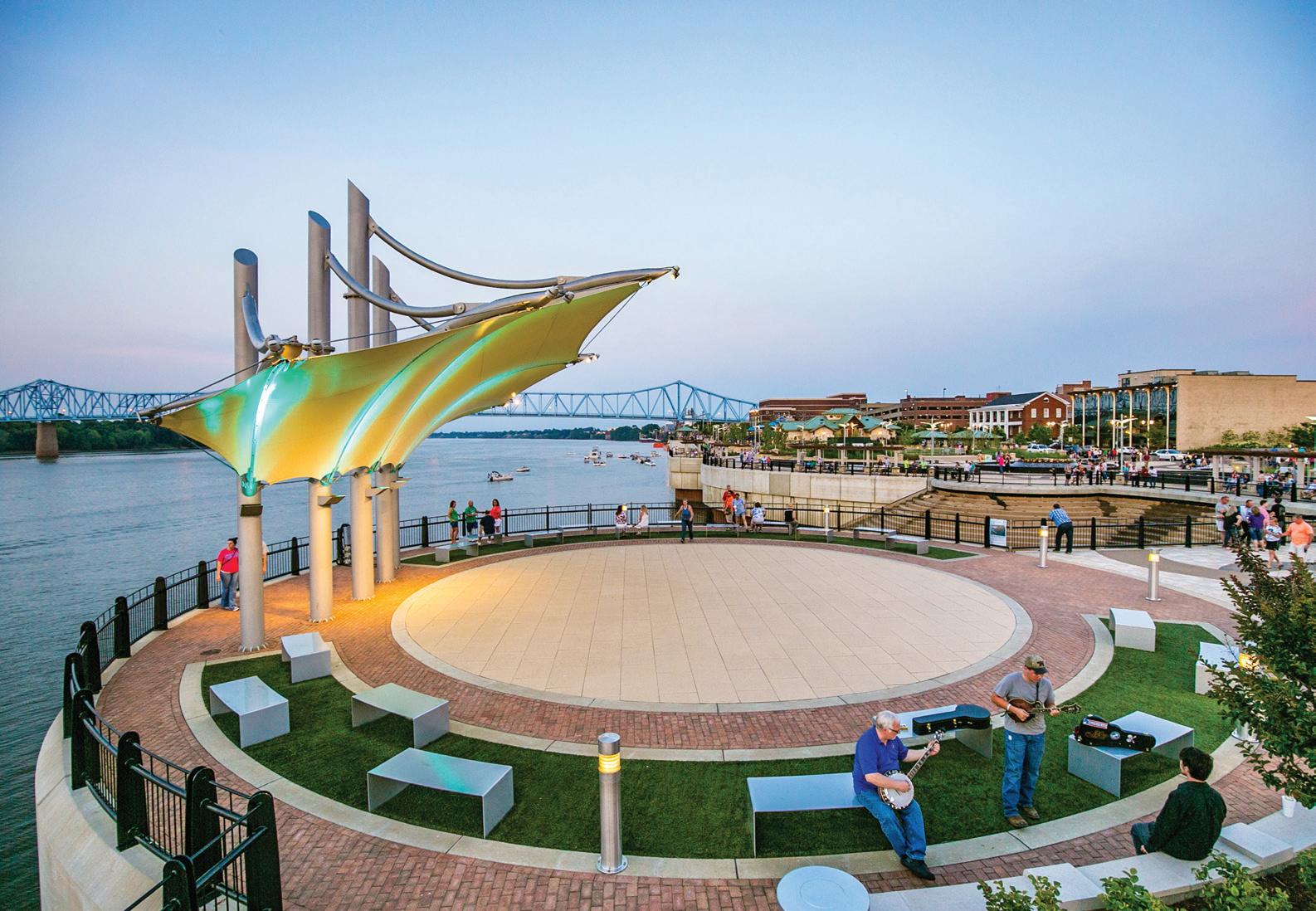
beautiful botanical gardens, alongside its quintessentially Kentucky attractions.
Kentucky’s contributions to bluegrass music are hard to overstate, and Owensboro bills itself as the Bluegrass Music Capital of the World. The city became the heart of this celebrated musical genre thanks to one of its signature attractions: the Bluegrass Music Hall of Fame and Museum. This museum honors all of the many talented musicians whose artistry shaped the music and explores the history of the genre through artifacts and curated exhibits.
The sleek $15 million museum opened in 2018 and is located right on the water in downtown Owensboro. It features 50,000 square feet of exhibits and a 450-seat the-
ater hall for concerts. It’s also the producer of events like the ROMP Festival, a bluegrass music festival held in Yellow Creek Park that lasts four days and features dozens of musicians. The theater regularly hosts performances and concerts, too.
Groups touring the Bluegrass Music Hall of Fame and Museum will learn about music history and see artifacts, including instruments, costumes, photographs and digital assets like video interviews. They can see exhibits dedicated to some of the best-known bluegrass musicians, from the “Father of Bluegrass,” Bill Monroe, to greats like Lester Flatt and Earl Scruggs. Rotating exhibits let guests explore a variety of musicians and eras of the genre, and there are also opportunities for hands-on fun, like photo-ops.
“There’s a lot for groups to do at the Bluegrass Music Hall
of Fame and Museum,” said Kirk. “There’s the theater hall for shows, the hall of inductees and their tours. And they can do a picking session, where they play a song on a bluegrass instrument, like a mandolin, fiddle, guitar or banjo.”
The hall of fame, founded in 1991, has dozens of inductees for visitors to learn about. Inductees include contemporary musicians who are still innovating within the genre, like Alison Krauss, who was inducted in 2021.
But the fun doesn’t stop at bluegrass. Other venues in the town, such as the riverfront and the downtown convention center, are also great places to find concerts and live music.
Visual arts are represented, too, at the Owensboro Museum of Fine Art. The museum, housed in a building on the National Register of Historic Places, has a collection with over 4,000 pieces of art from all over the world, including work by Pablo Picasso, Thomas Lawrence and Martin Johnson Heade. Admission is free.
One of the most famous barbecue spots in the whole state, let alone the city, is Moonlite Bar-B-Q Inn. Located in an unassuming brick building west of downtown, the restaurant has been delighting its customers since the 1960s and has racked up awards for its downhome fare. The restaurant is most famous for its barbecue mutton, served at a daily lunch and dinner buffet, which also includes mains like fried catfish, barbecue chicken, beef brisket and pork ribs. Burgoo, another Kentucky staple, is also on the menu.
Sides include more Southern comfort food, like cornbread, cole slaw, potato salad, barbecue beans and vegetables. It may be a tall order, but saving room for dessert is a must. Scratch-made pies, cobbler, banana pudding and a host of other sweet treats are all on offer, and a scoop of ice cream is the cherry on top.
Moonlite has 350-plus seats and bus parking for groups, Kirk said.
It’s also not the only barbecue spot in town; Old Hickory Bar-B-Que, closer to downtown, was founded in 1918 and is known for its hickory-smoked meats, including mutton, beef brisket, pork and chicken. The restaurant serves barbecue plates and sandwiches in a casual setting.
Finally, Ole South Barbeque, on the east side of town, considers itself the best-kept barbecue secret in Owensboro. It serves breakfast, lunch and dinner, and adds burgers to the menu in addition to the staples found at the other restaurants.
Beyond barbecue, several other noteworthy restaurants in the heart of downtown Owensboro include Colby’s Fine Food and Spirits, a diner-style restaurant with entrees ranging from prime rib to fried chicken; The Brew Bridge, a craft brewery that’s connected to a courtyard and arcade; and Goodwood Brewing, which serves elevated pub fare and is right on the water.

“Green River Distilling is just
a five-minute drive from downtown. They offer fully immersive tours of the property to see how the bourbon is made.”
— DAVE KIRK, VISIT OWENSBORO
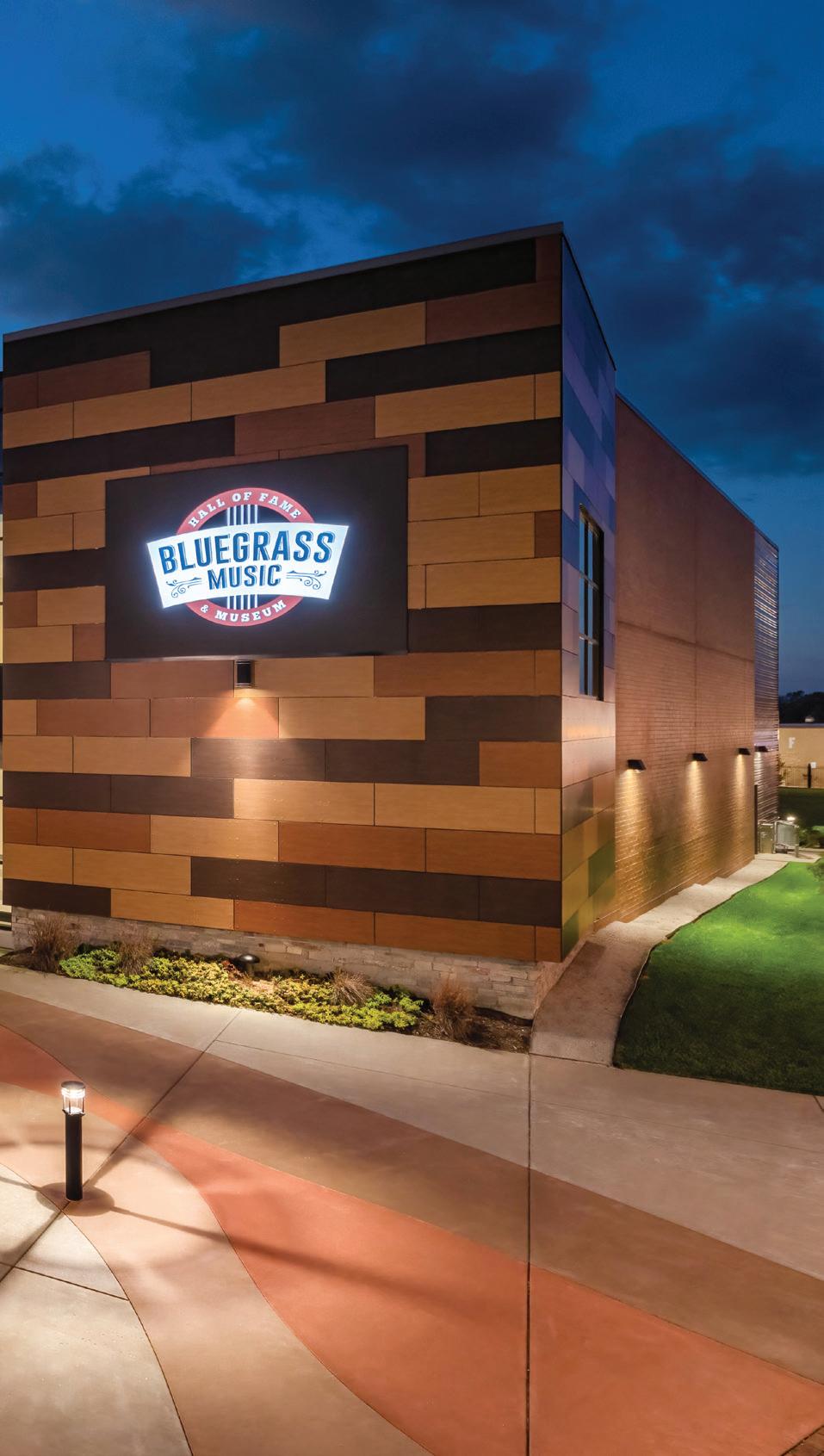
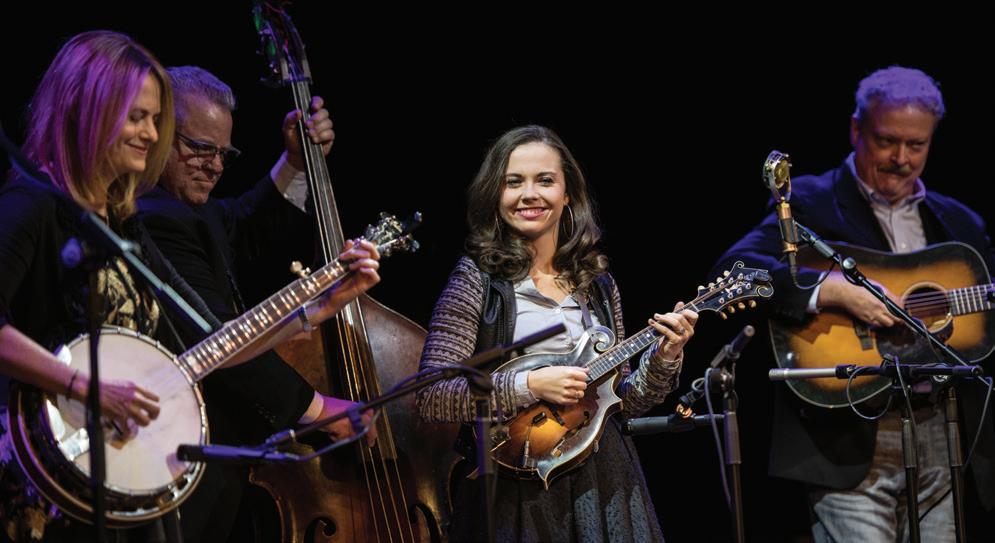
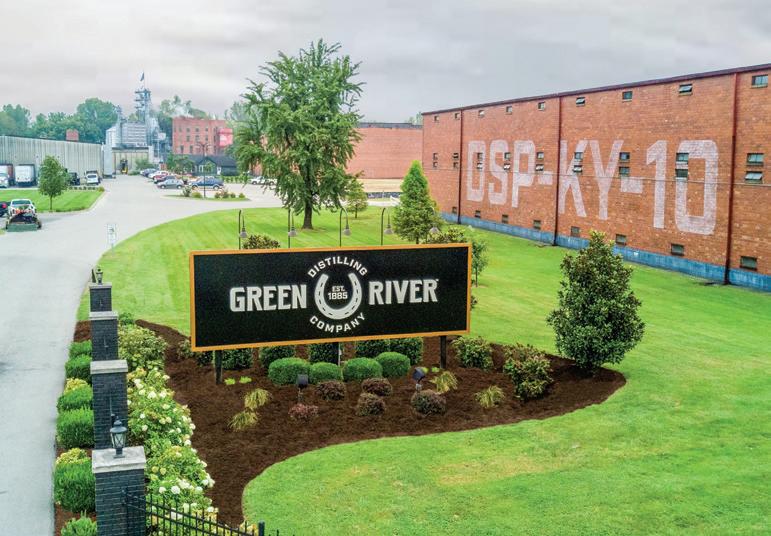

In addition to the great culinary scene in town, there are lots of ways for visitors to explore agritourism ventures in the nearby countryside.
“Lots of orchards surround the city,” Kirk said. “There’s Reid’s Orchard and Trunnell’s Farm Experience, where people can pick fruit and go for hayrides, too.”
The food scene in Owensboro isn’t complete without its robust spirits.
Its most famous spirit comes from Green River Distilling Company, a distillery on the far western edge of the Kentucky Bourbon Trail that produces upward of 95,000 barrels of bourbon each year. It was founded in 1885, which makes it the 10th oldest distillery in Kentucky. The 26acre campus is located right on the river.
“Green River Distilling is just a five-minute drive from
downtown,” Kirk said. “They offer fully immersive tours of the property to see how the bourbon is made.”
In addition to tours of the campus and traditional tastings, the distillery offers more hands-on bourbon-themed experiences, such as cocktail-making classes. There’s also the Barrel Thieving tour, a behind-the-scenes tour that lets guests sample bourbon directly from the barrels where it’s aging and comes with a glass guests can take home. The Single Barrel Distillery Tour lets groups join Aaron Harris, the company’s head distiller, for a guided, behind-the-scenes tour of the bourbon-making process.
The campus also includes a bourbon lounge and a gift shop.
Nestled in a little town called Santa Claus, Indiana, just a 36-minute drive from Owensboro, travelers will find Holiday World and Splashin’ Safari. The amusement park-waterpark combo is an impressive addition to Owensboro’s long list of

attractions and can make for a great group outing.
“We’re the closest major city to Holiday World,” Kirk said. “Holiday World is consistently ranked as one of the cleanest theme parks in America and as one of the best water parks.”
As the name would suggest, the park is themed around different holidays. That includes sections of the campus dedicated to the Fourth of July, Halloween, Thanksgiving and Christmas. Rides, attractions and eateries in each section have holiday-inspired names and color schemes, adding to the fun.
Several of the park’s roller coasters have earned accolades, including The Voyage (found in the Thanksgiving section), which was named among the top wooden coasters in America by Time Magazine and Golden Ticket Awards. The park’s other coasters, including The Legend and The Raven, are also great for thrill-seekers.
The adjoining waterpark, Splashin’ Safari, has been nominated for best waterpark in America by organizations like
“Holiday World is consistently ranked as one of the cleanest theme parks in America.”
— DAVE KIRK, VISIT OWENSBORO
USA Today and Tripadvisor for several years running, thanks to its rides like the water coaster known as the Mammoth.
“It’s got world-class attractions, but it’s small enough you can get around the park,” Kirk said.
In addition to being recognized for its cleanliness, the park also provides free soft drinks and free sunscreen to all of its visitors. Another perk is the park’s low price tag compared with other amusement parks.
“Tickets are super affordable compared with Disney, but it’s a big family destination so it mixes really well with what we offer here,” said Kirk.
VISITOWENSBORO.COM
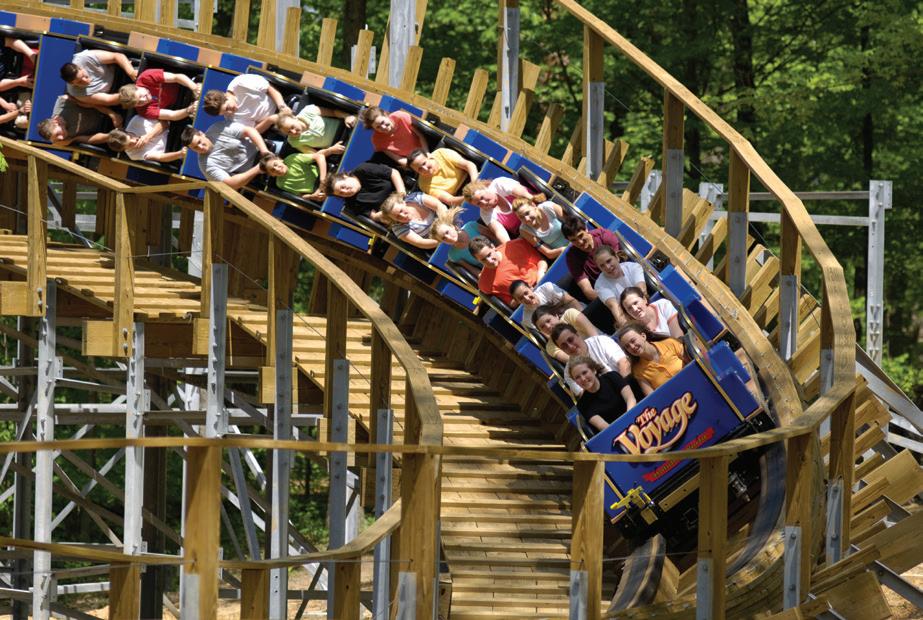




































































































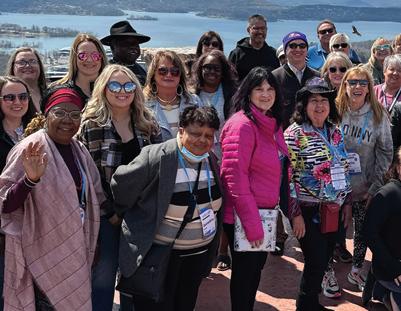






































































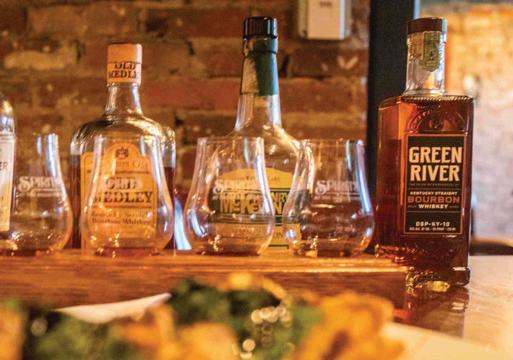























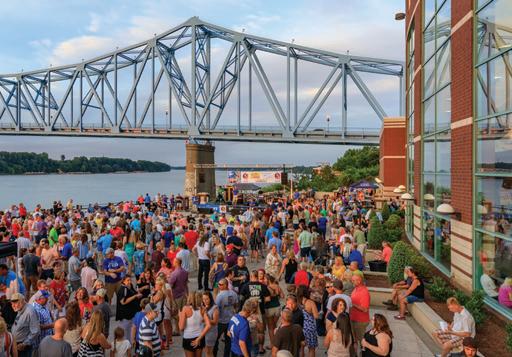






















































































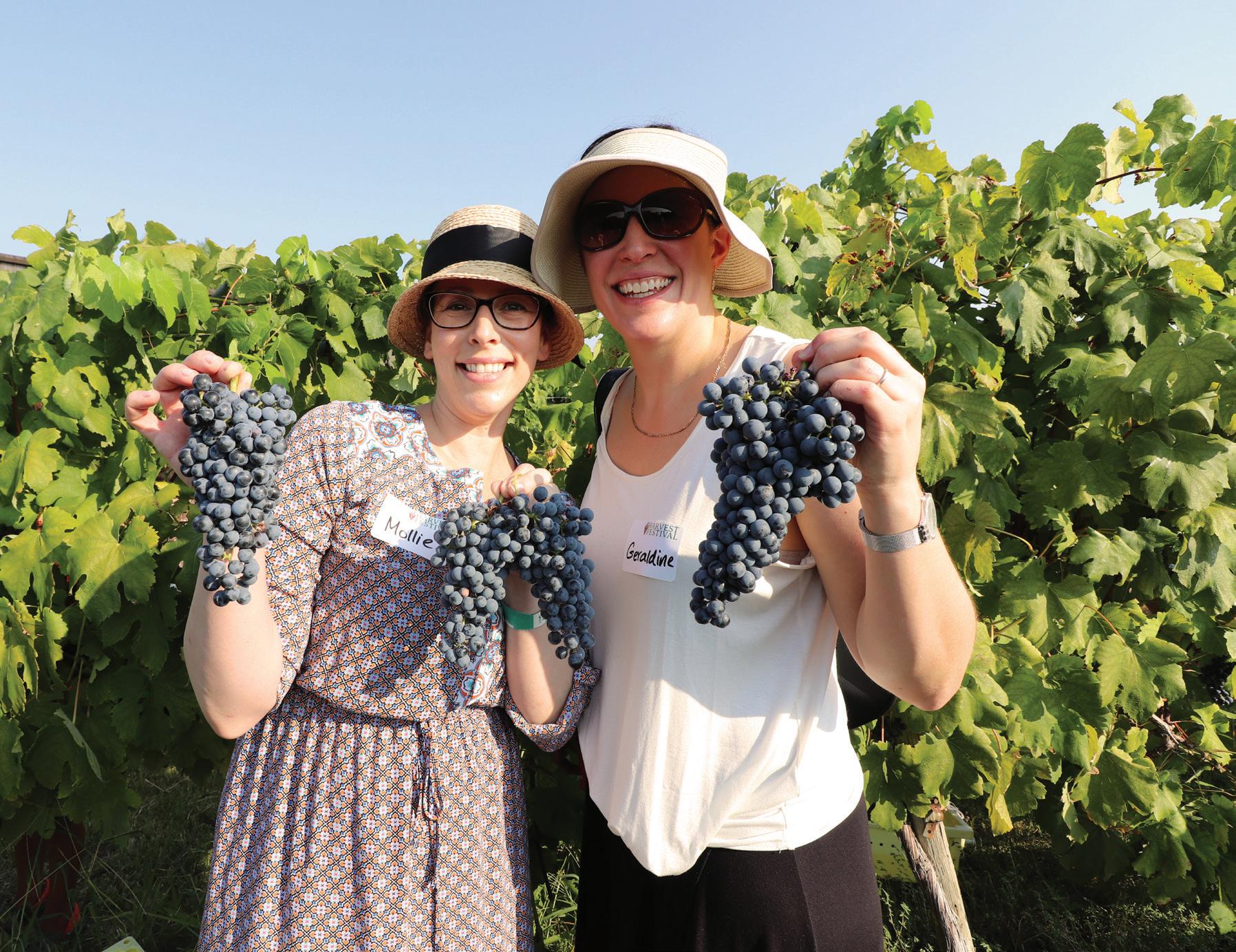


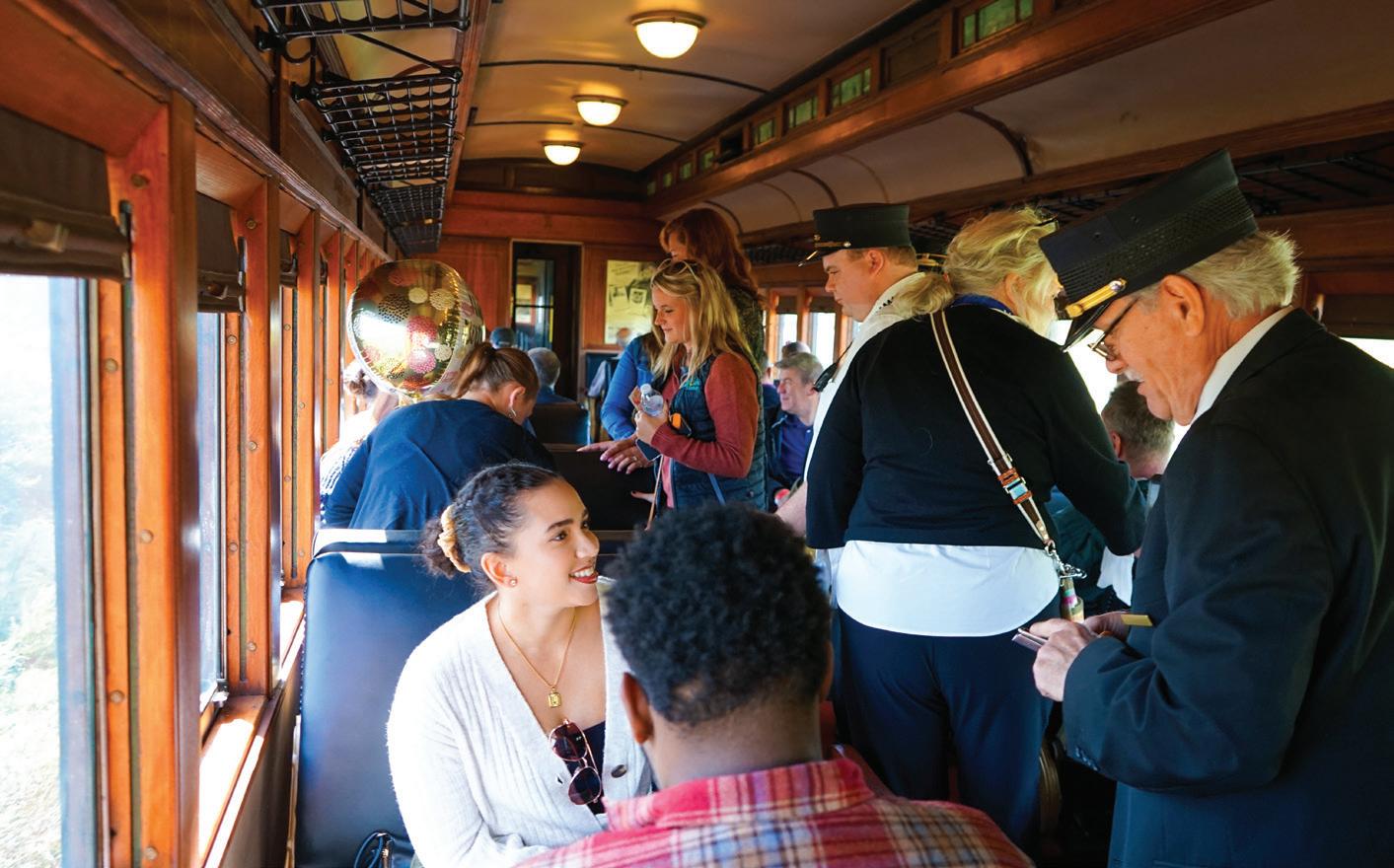

Horseback riding through a Charlottesville vineyard
BY RACHEL CRICK
Absorbing sun-soaked vineyard views, sampling flights of wine and peeking behind the curtain at the winemaking process — the typical group visit to a winery is already enchanting. But if a group is full of oenophiles or if the destination is an award-winning wine region, going
the extra mile to arrange an especially immersive activity or tour is often worth it.
Whether your travelers like their wine crisp and bubbly, dry and rich, or light and sweet, here are five distinct experiences that are sure to make a splash.
The Charlottesville area was named Wine Region of the Year by Wine Enthusiast in 2023, and for good reason. The area’s 40-plus vineyards are producing award-winning wines, and the Monticello Wine Trail, comprising more than 30 wineries, is drawing notice from tourists and critics alike. While visiting any combination of these vineyards is sure to delight groups, one tour operator is offering a more hands-on look at the grapes.
Indian Summer Guide Service has been giving horseback tours of vineyards in Charlottesville since its founding in 2010. The experience begins with a ride through the vineyard that lasts from an hour to 90 minutes. Then, the group heads back to the winery for a tasting or a glass of wine.
Ashton Beebe, founder and owner of the tour service, said the company prioritizes quality over quantity by giving small group tours of six to eight, making it feel less like a standard trail ride.
“We don’t make our clients go nose to tail,” Beebe said. “Keeping it as a
small, private experience makes people relax more. People come as strangers and leave as family.”
Large groups can be divided, with some enjoying the wine tasting experience first while they take turns riding through the vineyards. The experienced guides and small groups make it a good option for groups with first-time riders. The most popular time of the year for one of these wine tours is autumn, when the weather is cooler and the Blue Ridge Mountains and vineyards turn vibrant shades of gold, orange and red.
Groups can choose from several local wineries to tour, including Veritas Vineyard and Winery, Merrie Mill Farm and Vineyard, Cunningham Creek Winery, Pollak Vineyards, Chiswell Farm and Winery, and Keswick Vineyards. In addition to vineyard tours, Indian Summer Guide Service also offers tours of a few local cideries and breweries. indiansummerguideservice.com
One of the most famous wine regions in the world, Napa Valley features several picturesque towns and hundreds of vineyards, wineries and tasting rooms. This California county has an abundance of wine experiences, ranging from conventional tastings to amped-up excursions synonymous with luxury.
One such experience can be found at Raymond Vineyards, a member of the Boisset Collection, a prestigious group of brands found at a handful of wineries around Napa Valley. Raymond Vineyards, in St. Helena, was founded in 1970 and has been prominent in the area ever since. Today, it’s known for its luxurious tasting room and its high-quality wines, including its cabernet sauvignon, merlot and chardonnay.
But in addition to its standard tasting experiences, the winery also offers a more hands-on opportunity for groups to learn about wine and its production. The Winemaker for a Day experience allows groups unprecedented access to the wine-making process. They’ll spend their time in the winery’s blending room, learning about wine and creating their own Bordeaux-style red blend. Once they’ve created a blend to their liking, the winery will bottle it, cork it and even create a custom label for the bottle. Visitors can take it home that day, and the winery can even produce cases of their custom blend. Groups of up to 12 can reserve this exclusive experience. raymondvineyards.com
It may come as a surprise to learn that New Jersey is increasingly earning recognition for its wines. While perhaps not the most famous wine region on the East Coast, the Garden State has been producing a respectable range of
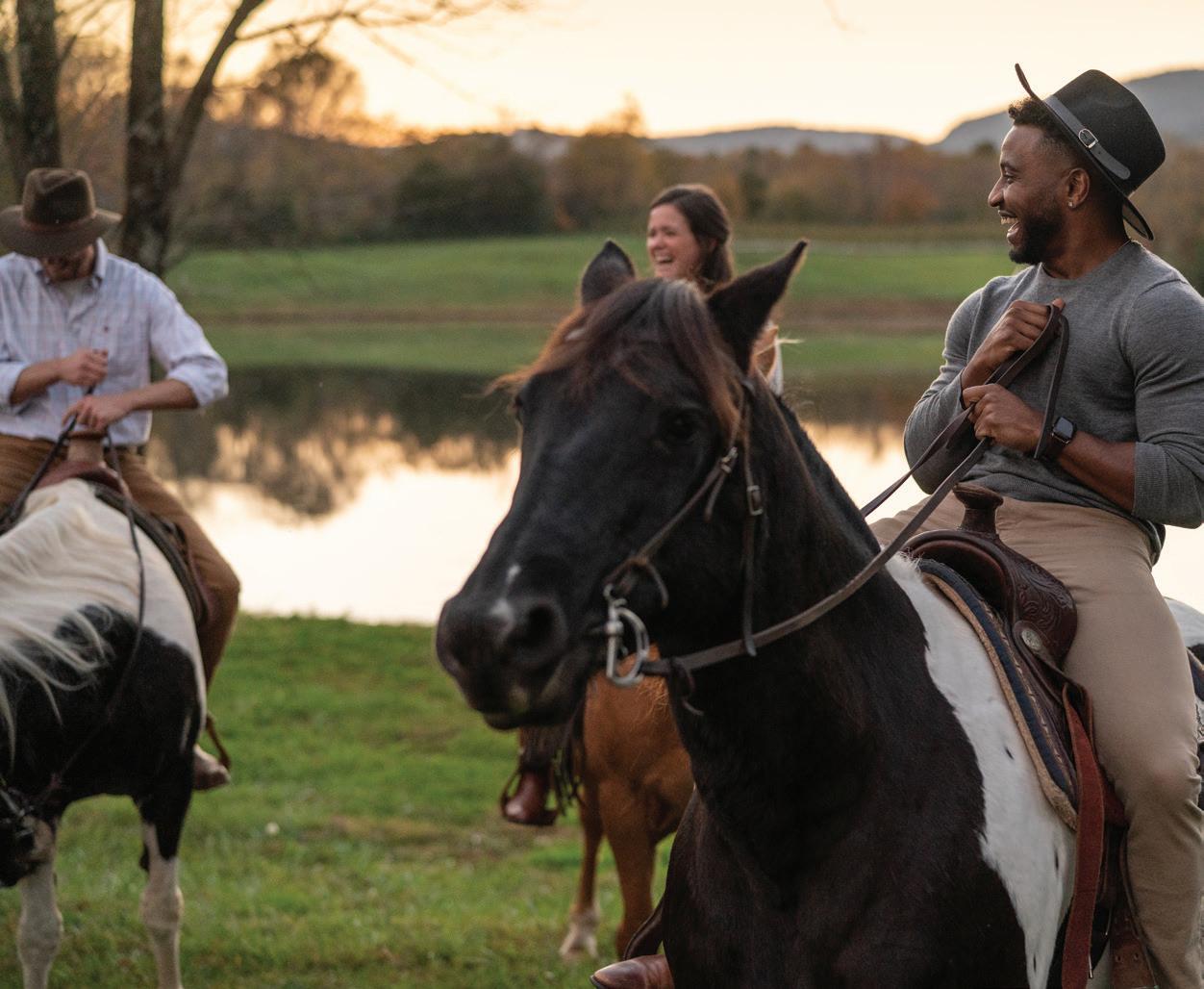








varietals in its four different growing regions, from chardonnay and riesling to sweeter wines. One of the best ways for a group to experience New Jersey wine combines antique train travel with more traditional wine experiences.
The Hunterdon Wine Express is the product of a collaboration between the historic Black River and Western Railroad, a volunteer-run organization dedicated to the upkeep of the antique train in Flemington, and Old York Cellars, a winery in Ringoes. Every stage of the wine production process happens at Old York Cellars, from growing the grapes to bottling the wine.
“The wine train offers an experience that goes beyond the grape,” said Karin Colantuono, marketing manager at Old York Cellars. “It’s a unique experience taking a classic train through our bucolic countryside. Then for the tasting, you’re right in the vines. You really get that immersive experience.”
First, the group boards the historic train at the station in Flemington. Once the train departs, an Old York Cellars representative begins telling the winery’s story as guests enjoy beautiful views of the New Jersey countryside. When they arrive at the station in Ringoes, they’re shuttled to the winery for a charcuterie and tasting experience of six wines. Then, they’ll enjoy lunch at the winery and look around the vineyard before being shuttled back for the return trip.
The train’s capacity is 49 passengers, and excursion dates are coordinated with the railroad based on volunteer availability. However, private events are considered on a case-by-case basis.
oldyorkcellars.com






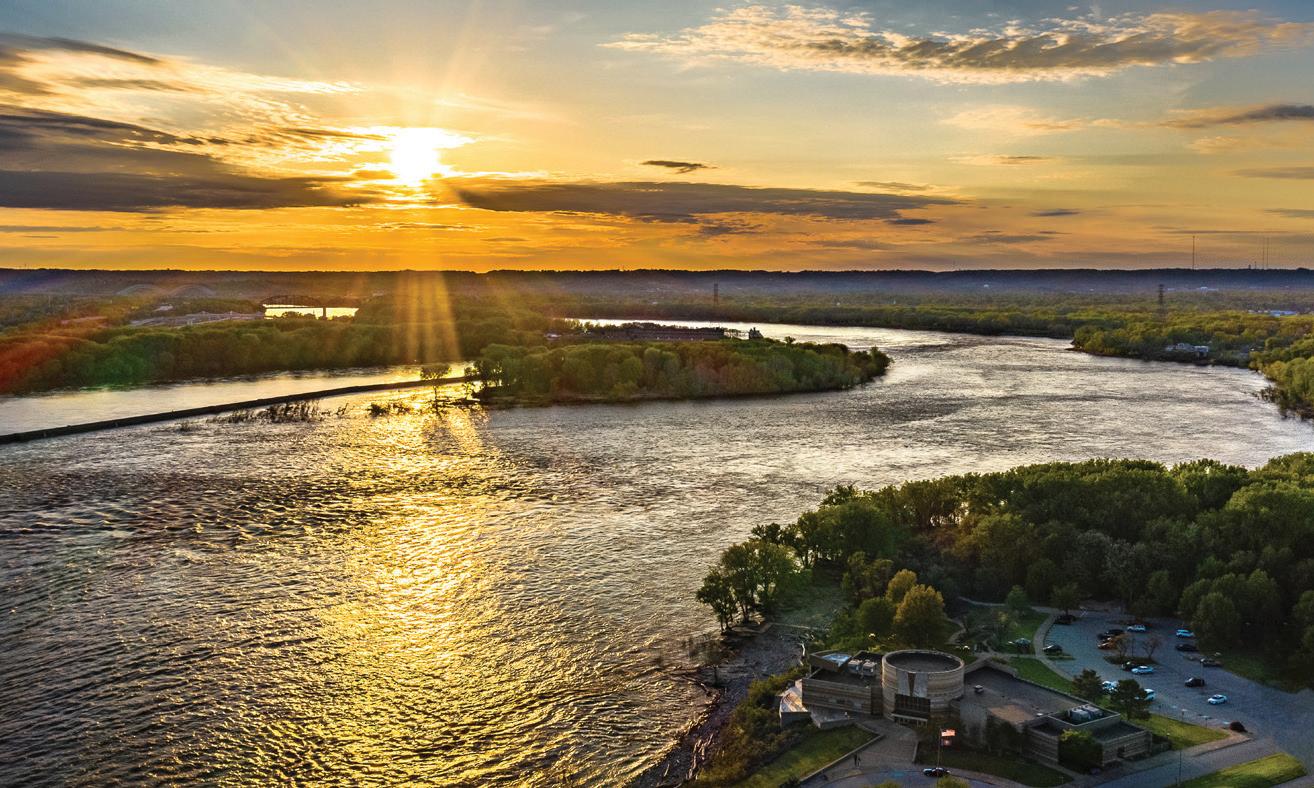









In a state as large as Texas, the wine produced varies greatly based on weather and region. However, Fredericksburg and the surrounding Texas Hill Country have earned a reputation as the state’s preeminent wine region. To spend a day immersed in the local wine — literally — groups can take part in a grape stomp at a local winery.
One grape-stomping opportunity comes around harvest time at Messina Hof Winery, which was founded in 1979 and now has several locations in the area. It produces wine from Texas-grown grapes and is known for its port, cabernet sauvignon, sagrantino, riesling and chenin blanc. But it also offers quite a few activities to go along with the vintages. These include grape stomping and grape picking at several of their locations. At the Estate Winery in Bryan, grape picking and stomping are available the first four weekends in August. It’s also an offered activity at the harvest festival at the winery’s location in Fredericksburg, which is held the last weekend of August. At the Estate Winery, groups can pick the grapes, then stomp them and press their feet into a T-shirt. Four to five people can fit in each stomping bucket, and it’s an activity guaranteed to generate laughter. Then they’ll enjoy a tasting and tour and can even opt for an additional dining experience. Groups larger than 10 get a discounted rate.
“It’s a very bucket-list unique experience that goes well beyond just having a wine tasting,” said Gina Graves, marketing manager at Messina Hof Winery. “It’s a very casual way to approach wine. Sometimes people view wine as stuffy, but this is fun.”
messinahof.com



The Willamette Valley is Oregon’s signature wine region. Located on roughly the same latitude as the lauded wine region in Burgundy, France, its prize varietals include pinot noir and chardonnay. It’s also a region known for abundant agriculture, thanks to its plentiful rain.
That’s where The Kitchen at Middleground Farms comes in. This recreational cooking school located on a 17-acre farm in the Willamette Valley emphasizes cooking with fresh, seasonal ingredients produced on the farm. Once a month (and twice in May, which is Oregon Wine Month), the farm hosts Winemaker’s Dinners, where they partner with a specific winery in the Willamette Valley.
“We go out and taste through all of their wines to determine what we want to focus on, because we want guests to learn about pairing,” said Jessica Hansen, owner, founder and chef of The Kitchen at Middleground Farms. “We pick the wines, then we create a tasting. We are intentional about showcasing the wine.”

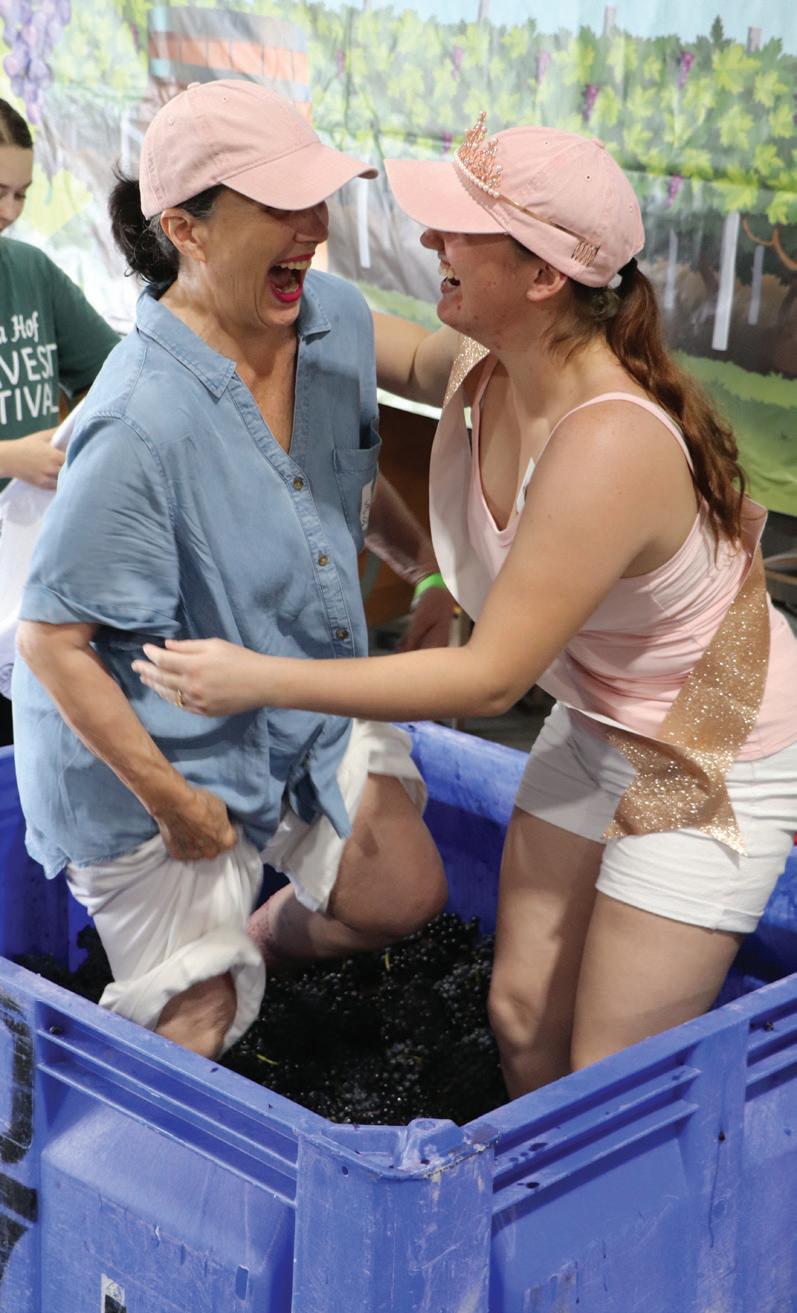
Groups can mosey through the farm to see its livestock and its produce while enjoying a welcome beverage, then enjoy a fivecourse, farm-to-table meal. Each course is perfectly paired with a wine. They’ll learn about the food and wine and even have access to the winemaker to learn more about the process from grape to glass.
“People like to meet the winemaker,” Hansen said. “To get access to the winemaker is unique. That’s what makes these special.”
Wine dinners max out at 30 guests, but the farm offers an abundance of other experiences, from group cooking classes to private events to a small wine festival highlighting the region’s great wineries. middlegroundfarms.com
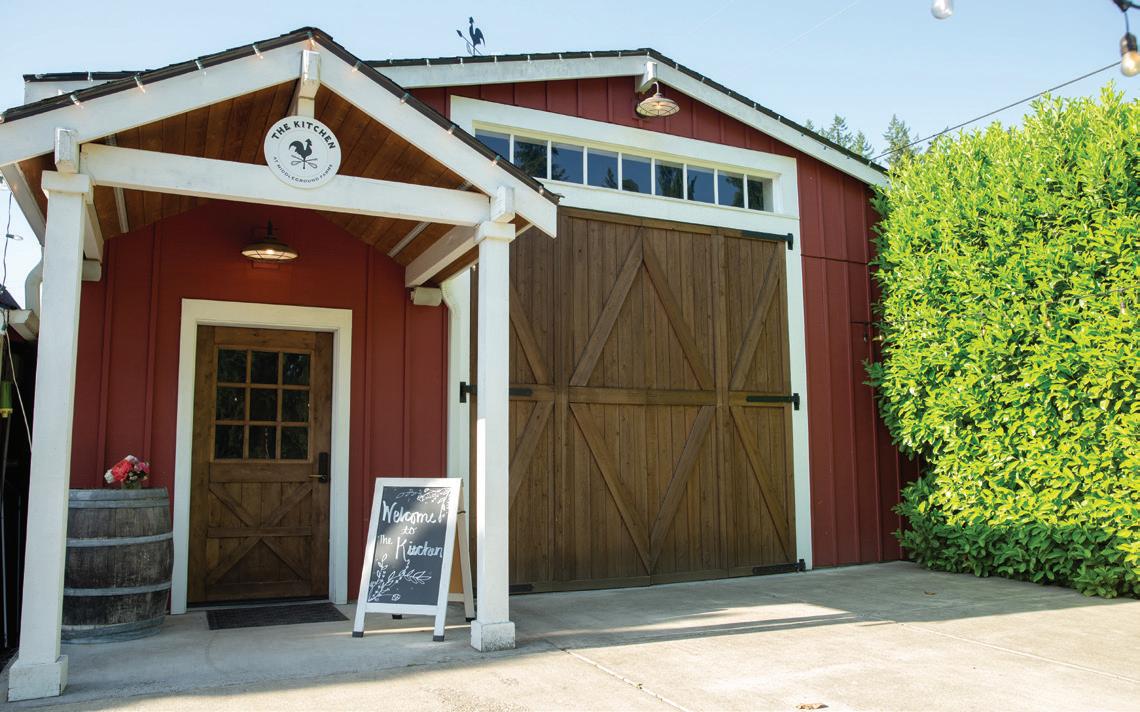
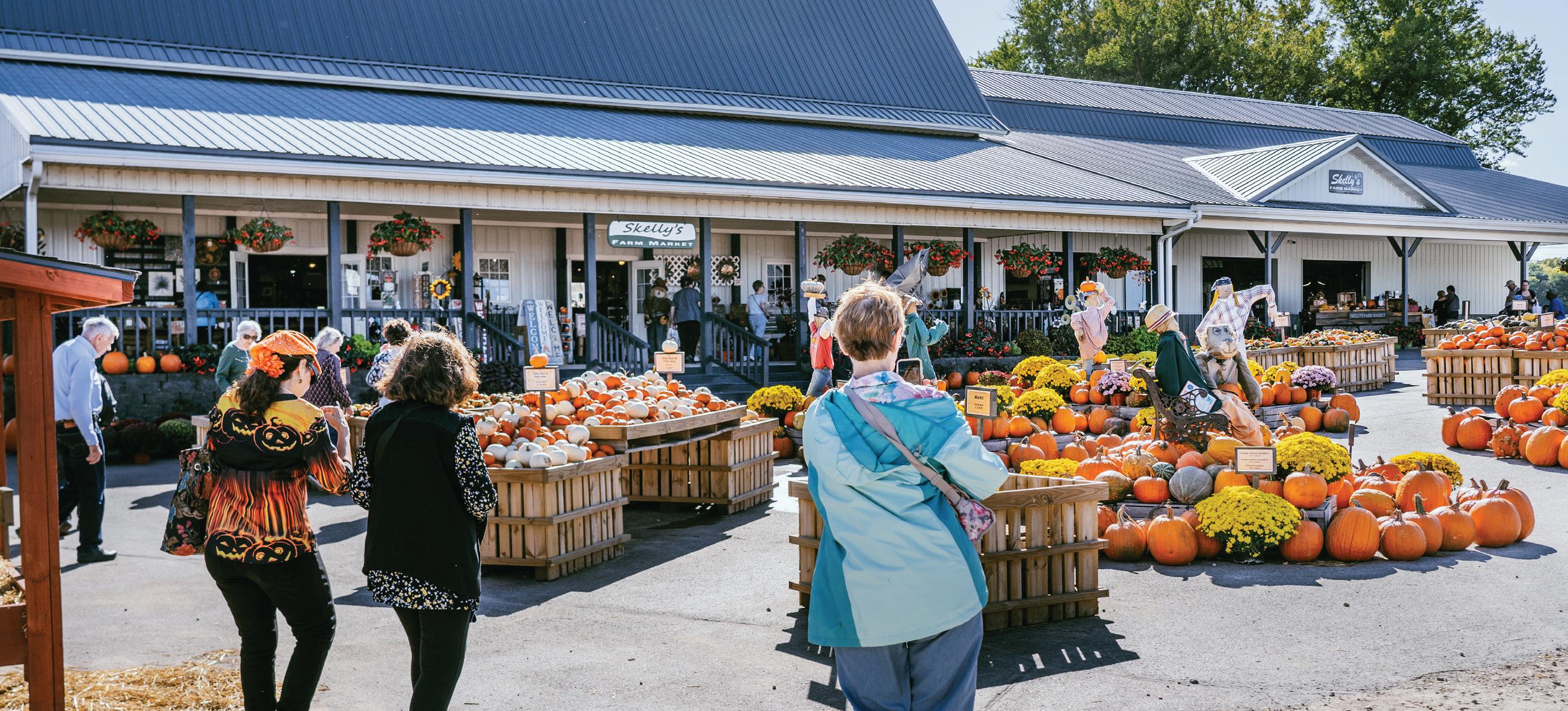
BY ELIZABETH HEY

Kansas City is known for its barbecue and is home to over 100 barbecue restaurants.
Missouri has mastered the open road
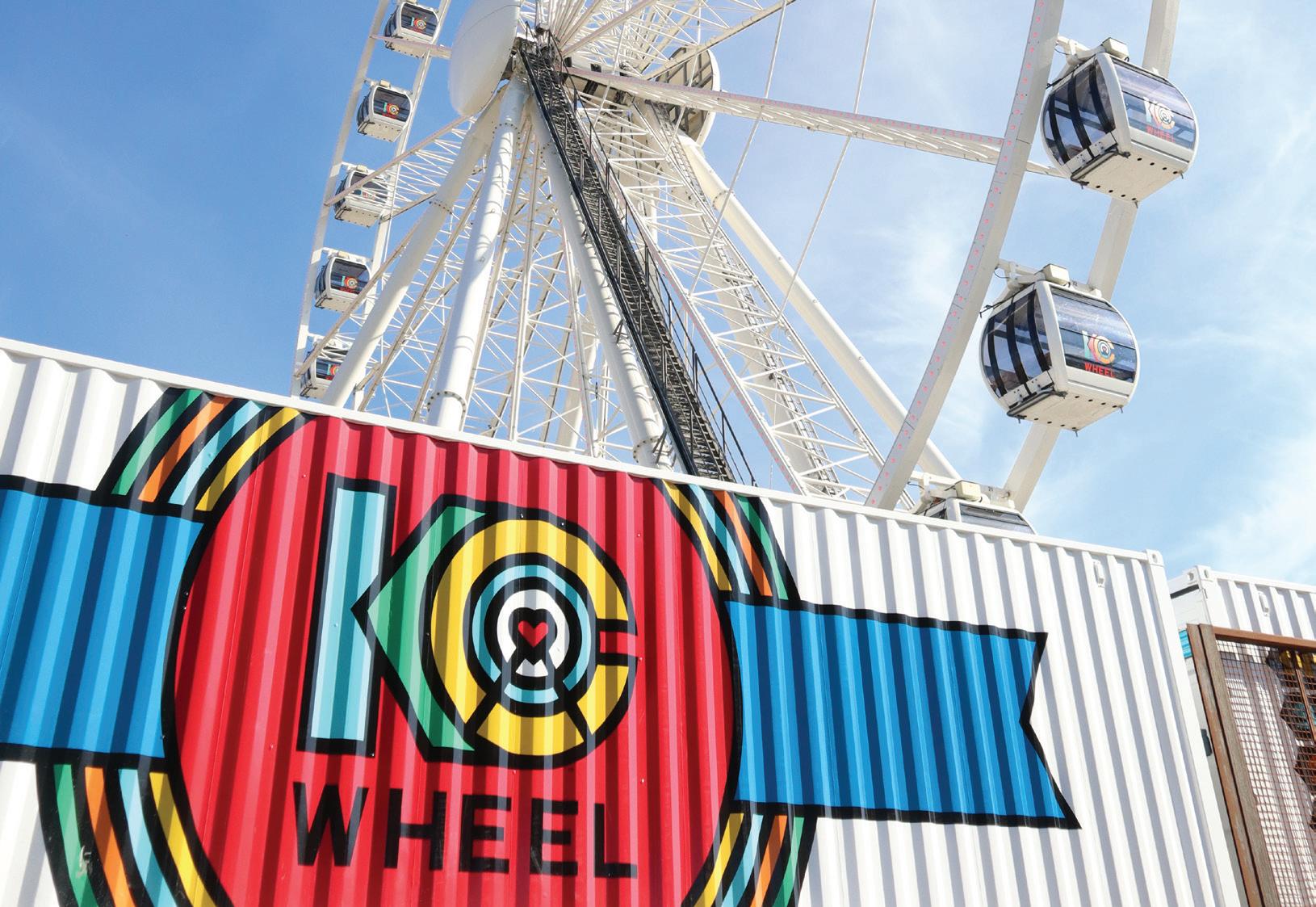
Missouri might just be responsible for the Great American Road Trip.
Passion for road trips was ignited when President Dwight D. Eisenhower signed the Federal-Aid Highway Act in 1956. Missouri was awarded the nation’s first contract to build an interstate highway, now Interstate 70, and introduced travelers to the wonders of the American road.
Bisecting the state, I-70 simultaneously connects Kansas City on Missouri’s western border to St. Louis on its eastern boundary. Each of these cities has its own claims to fame. Smaller towns in between — Arrow Rock, Columbia, Rocheport and Hermann — contrast these two sophisticated cities.
Here’s a sampling of stops that qualify as destinations or can be strung together for a memorable road trip.
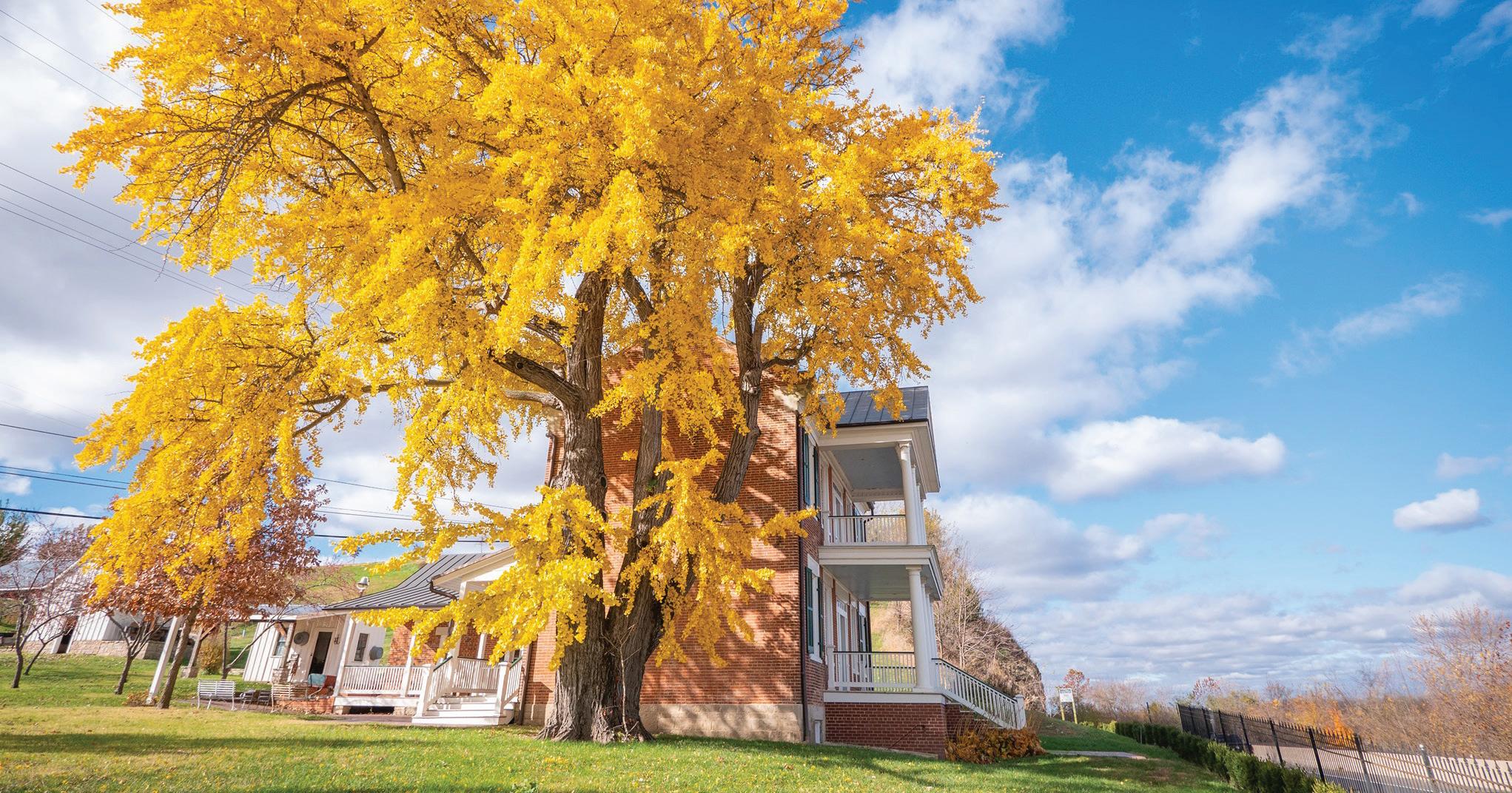
Kansas City started as a cattle town in the 1800s but has grown into a cosmopolitan destination with a trendy arts and culinary scene, as well as globally recognized museums and sports venues.
At the moment, the city has a strong wind in its sails. In March, Kansas City’s professional women’s soccer team, KC Current, debuted CPKC Stadium. Situated on the banks of the Missouri River, it seats 11,500 fans.
“Because the new CPKC Stadium is the world’s first stadium purposely built for a women’s professional sports team, it brings great energy to our city,” said Makenzie Wolters, communications manager for Visit KC. “In the coming years we’ll see even more development in our riverfront area.”
From James Beard award-winning fare to barbecue, Kansas City’s food scene is robust. With more than 100 barbecue restaurants, the KC BBQ Experience app tracks diners’ barbecue adventures and offers themed barbecue trails. And each year, Kansas City hosts the “World Series of Barbecue,” with more than 600 competing teams.
Unique museums include the National World War I Museum and Memorial — the country’s only museum focused solely on World War I. Baseball lovers can check out the Negro Leagues Baseball Museum, the world’s only museum dedicated to preserving and celebrating the rich history of African-American baseball. And in the nearby town of Independence, the Harry S. Truman Presidential Library and Museum reopened in 2023 with state-of-the-art technology after the largest renovation in its history.
Just south of downtown, Crown Center contains restaurants, shops, SEA LIFE Kansas City Aquarium and the Hallmark Visitors Center. The Link, a glass-covered above-street walkway, connects to Union Station, the restored grand dame of Kansas City’s railroad days, and Science City. Nearby, Pennway Point’s new KC Wheel, a 150-foot observation wheel with 36 enclosed gondolas, boasts 360-degree views.
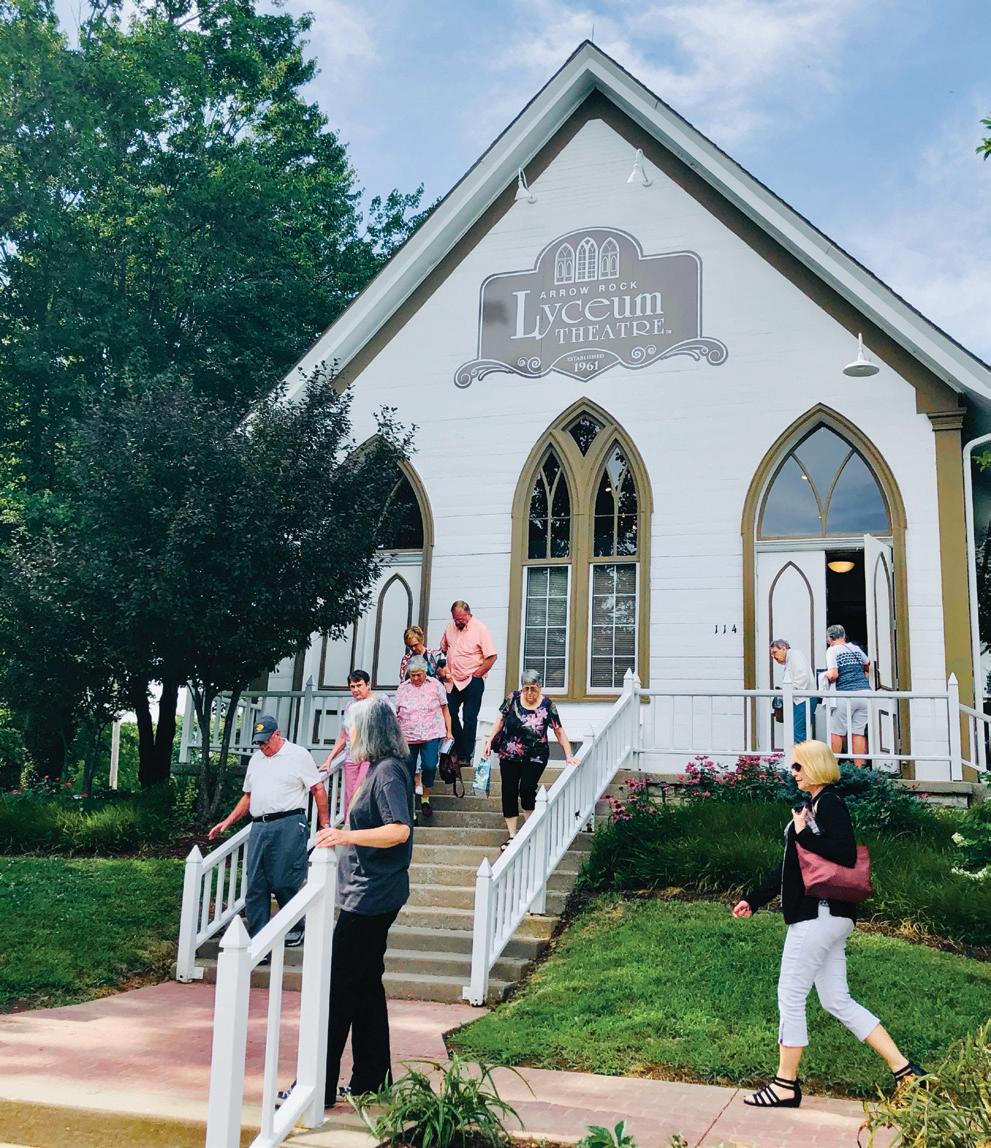
BY ELIZABETH HEY
Founded in 1833 and named for the nearby bluffs resembling arrows, the entire village of Arrow Rock has been designated a National Historic Landmark. Arrow Rock State Historic Site introduces visitors to Boone’s Lick Country via exhibits and a 20-minute video. Town tours highlight the J. Huston Tavern; the home of George Caleb Bingham, one of Missouri’s most notable artists; and the Sites house and gun shop. Several buildings are available for event rental including the Brown’s Chapel Free Will Baptist Church, built by the local African American community in 1869.
Arrow Rock Lyceum Theatre became the first theater in the state to receive the Missouri Historical Theatre designation. Since 1961, the 416-seat theater has been housed in a picturesque white clapboard church. June through early October, Broadway-style productions cast local and East Coast actors. The theater season concludes in December with its annual production of Dickens’ “A Christmas Carol.”
Multi-faceted Columbia’s buzz usually centers around the University of Missouri and SEC sports. However, this town heartily supports the arts and offers many outdoor diversions. The Columbia Art League Gallery hosts year-round ex-
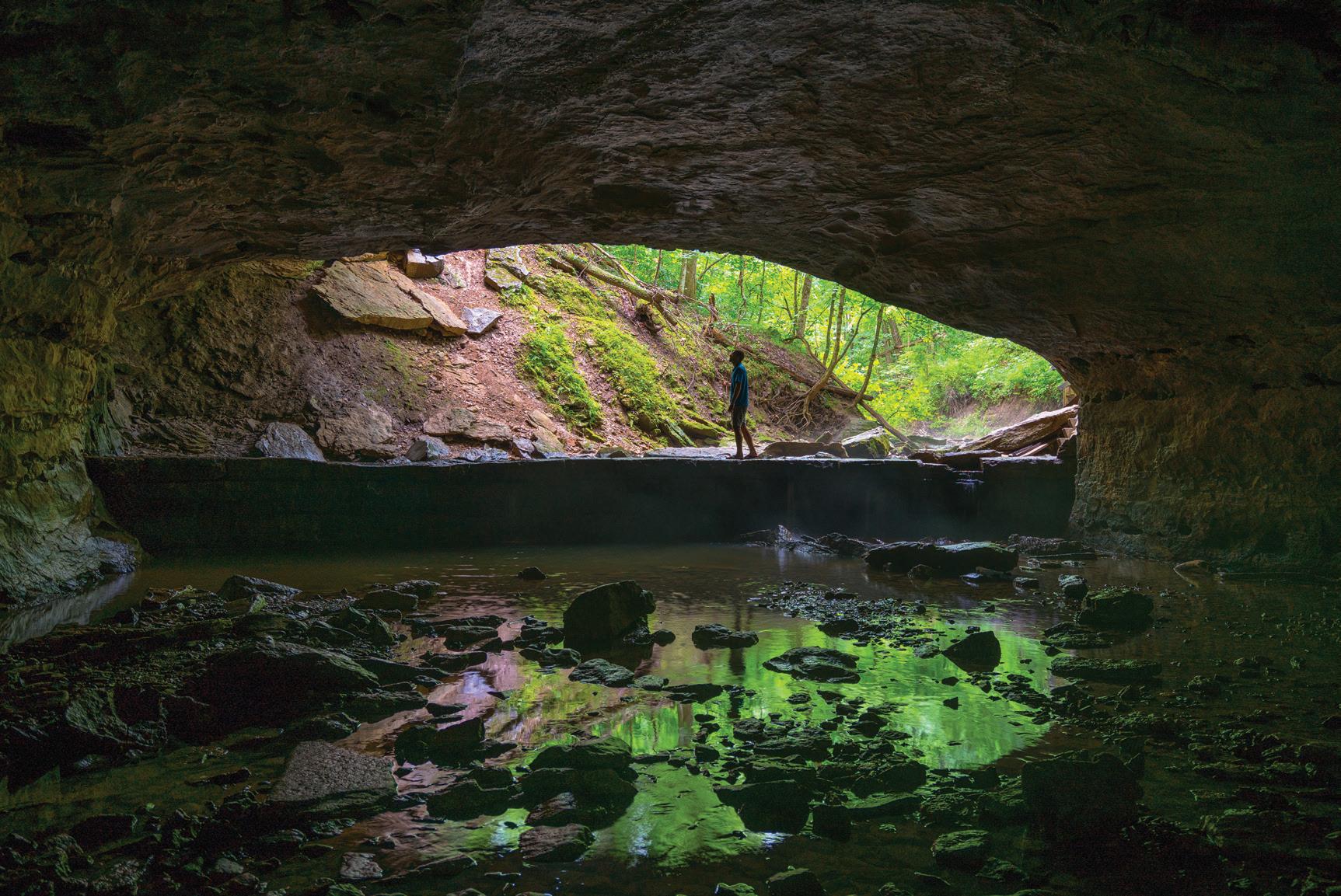
hibits, and June’s Art in the Park showcases more than 100 juried national artists. Artrageous Fridays, hosted the first Friday of each month in the nineblock North Village Arts District, invite the public for an art crawl through galleries and shops alongside live music, art demonstrations and tasty food.
“We’ve always had a really had a strong arts-and-culture community that’s continually evolving, with the True/False Film Fest anchoring events in early March,” said Amy Schneider, director for Columbia Convention and Visitors Bureau. “Almost every weekend there’s live music playing at one of our many venues, such as on the riverfront or at our downtown street concerts on Ninth Street.”
Lovely Shelter Gardens supports five acres of more than 15,000 annuals and perennials and 300 varieties of trees and shrubs. Its free concert series takes place on Sundays during June and July. Nearby Rock Bridge Memorial State Park sits on more than 2,200 acres with 11 trails. Interpretive programs highlight the park’s diverse geology. Its half-mile loop, Devil’s Icebox Trail, features the park’s namesake 63-foot-high rock bridge, sinkholes, a natural spring and underground stream.
Cyclists of all experience levels will enjoy the Katy Trail, the nation’s longest converted rails-to-trails project. Several miles west of Columbia, the trail’s
“The farm’s mules were used in Germany during World War II.”
— TAMMY BRUCKERHOFF, COPPER MULE DISTILLERY



only railroad tunnel lies in charming Rocheport. Trailside, Meriwether Café and Bike Shop serves all-day scratch breakfasts (including killer pancakes) and lunches using locally sourced ingredients. Rocheport’s Les Bourgeois Vineyards offers options for tastings, behind-the-scenes tours and dining in their Blufftop Bistro or A-Frame Winegarden with lofty river views.
Designated the nation’s first wine appellation before Prohibition shut down production, Hermann lies 15 miles south of I-70. Within a small radius, more than 10 wineries offer tastings. Oktoberfest runs every full weekend in October. Stone Hill Winery gives tours of the largest series of underground arched cellars in North America with more than 175 years of history. Its Vintage restaurant features German specialties in a restored horse barn and carriage house.
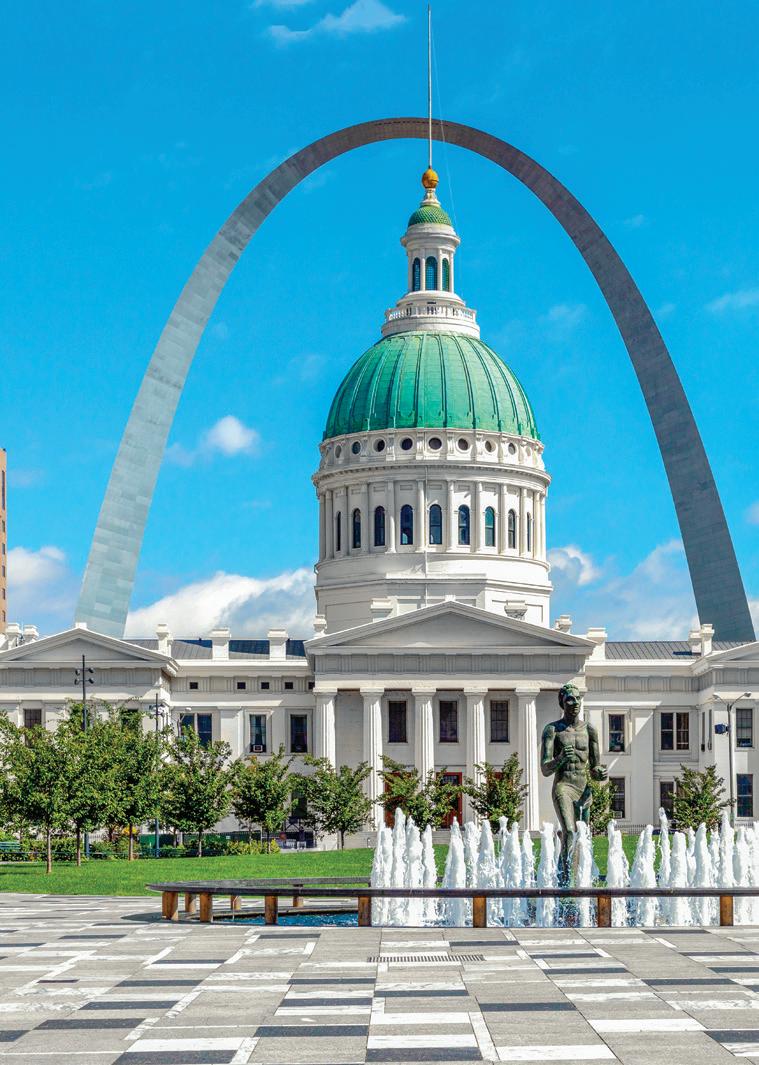
Within city limits, the 200-acre Hermann Farm showcases black shire draft horses. The on-site Hermann Farm Distillery uses locally grown grain and white oak barrels charred just down the road. Tailored carriage rides feature distillery tastings and tours of the 1847 Teubner-Husmann Greek Revival home. Adjacent Copper Mule Distillery treats visitors to chocolate and bourbon tastings plus educational tours of the rack house and production facility.
“The farm’s mules were used in Germany during World War II,” said Tammy Bruckerhoff, tourism director for Visit Hermann. “Groups will hear that story at Copper Mule Distillery, along with many other stories that highlight our history.”
Many of Hermann’s restored red brick buildings are on the National Historic Register. Antique stores and boutiques line the sidewalks. On Fourth Street, The Showboat Live Theater hosts movies and productions. This summer, professionals from St. Louis and locals presented “The Sound of Music.” Lodging varies from boutique hotels to small cottages and upscale bed and breakfasts.
The first thing most visitors to St. Louis notice is the Gateway Arch, towering above the banks of the Mississippi River. The nation’s tallest manmade monument stands as a tribute to the gutsy determination and ingenuity of its builders. Before boarding an enclosed tram pod for a ride to the top, groups should visit the Westward Expansion Museum, which dives into St. Louis history and the arch’s construction.
Across the street, the Old Courthouse is under renovation and slated to reopen next spring. Built in the 1830s, the courthouse is now a museum, and new exhibits will dig into the Dred Scott and Virginia Minor cases.
Forest Park reflects the heartbeat of St. Louis. Outdoor musical theater at The Muny thrills audiences, and the Saint Louis Zoo houses 16,000 animals. Missouri Botanical Garden features lush blooms, a tropical rain forest conservatory, Japanese gardens and tours of founder Henry Shaw’s 1849 Italianate mansion. Sassafras Cafe refreshes with indoor and outdoor seating framing spectacular views.
Midtown’s exciting developments include City Foundry STL and Armory STL. City Foundry STL, housed in an abandoned metal foundry, contains local shops, a food hall with 17 local vendors, high-tech Puttshack, Sandbox VR and a 10-screen movie theater. Opened in May, Museum of Illusions St. Louis delivers an immersive experience using mind-bending installations. The Armory STL, best described as an adult playground, has live music, the Midwest’s biggest screen, food and cocktails, and oversized yard games.
“These entertainment districts are next level and speak to the renaissance of our city,” said Catherine Neville, vice president of communications for Explore St. Louis. “They’re thoroughly entertaining and spark everyone’s imagination.”
Perfect for groups, the Kitchen Conservatory offers more than 900 cooking classes annually. Classes can range from demos to hands-on workshops and feature seasonal produce. Afterward, participants can check out their store, which sells more than 6,000 cooking products and tools.
visitmo.com

Atlanta — big, busy, sometimes boisterous — is a challenge to get your hands around.
How do you plan a visit to a destination this diverse and so full of choices? One way is to limit the geography, tap into a few famous attractions and then throw in a surprise or two to keep everyone entertained.
Here are suggestions — mostly within a small radius right downtown — that include viewing the world’s biggest fish, trying to kick a field goal, contemplating America’s civil rights history, strolling or rolling through a linear arboretum, and taking a side trip to a destination with French flair.
BY TOM ADKINSON
Centennial Olympic Park, Atlanta’s lasting tribute to the 1996 Olympics, offers open green space in the heart of the city that is populated with and surrounded by major attractions. The one that makes the biggest splash is the Georgia Aquarium, which by many measurements is the biggest aquarium in the Western Hemisphere. The most notable measurement is volume of water — more than 11 million gallons. More than half of that is in the Ocean Voyager exhibit (263 feet long, 126 feet wide and 33 feet deep), which is big enough to be home to a mild-mannered whale shark, the largest fish species in the world (average length of 18 to 32 feet).
In all, there are 500 species in 100 habitats. While it’s easy to marvel at the gigantic whale shark, smaller species are just as intriguing. Time seems to stand still as you watch sea dragons float through their serene habitat, chuckle that you’ve found Nemo in the clown fish tank and admire the underwater antics of sea otters and penguins. Sea lions and bottlenose dolphins are stars of shows in two substantial theaters. Just remember that the “splash zone” seats carry that label for a reason.
A different kind of entertainment is across the street from the aquarium at the College Football Hall of Fame, where famous football quotes are inscribed in the lobby floor (“Tough times don’t last. Tough people do.” — Paul “Bear” Bryant). Rising from the lobby is a three-story wall of more than 750 college football helmets. It’s a challenge to find your favorite team’s headwear amid the colorful display.
The top level is the actual hall of fame, a tribute to more than 1,000 players and coaches, and the display area for the MacArthur Bowl, the actual trophy for the NCAA Division I football champion. It’s a model of the Yale Bowl, and if you think it’s especially shiny, you’re right. Four hundred ounces of Tiffany’s finest silver (value of about $500,000) should sparkle.
The next level includes a variety of participatory displays. Show your team spirit at the college fight song karaoke machine, see whether you have the oratorical skills to sit behind a sports broadcast desk or (probably) humble yourself at the machine that measures your vertical leap. More fun and games are on the bottom level at the Peach Bowl Skills Zone, where the artificial turf sets the stage to see how well you can run a pass route, pass a ball downfield into a target net or kick a field goal. If nothing else, it’s fun to watch other people discover how difficult kicking a field goal really is — and there’s not even anyone rushing the kicker.
Atlanta played a pivotal role in the Civil Rights Movement, and two historic sites invite travelers to explore that story — the National Center for Civil and Human Rights (NCCHR) near the aquarium and the Martin Luther King Jr. National Historical Park, located only a 15-minute streetcar ride to the east.
The NCCHR weaves together the American Civil Rights Movement of the 1950s and ’60s with the global human rights movements ongoing today. For younger people who have no personal connections to the 1950s and ’60s, dis-
plays such as one that puts visitors in the center of a lunch counter desegregation conflict are especially powerful. (Note: The NCCHR has begun an expansion project and will be closed from January–August 2025.)
Touchstones of Martin Luther King. Jr.’s life are spread through the multi-block MLK National Historical Park. They stretch from his birth home to the original Ebenezer Baptist Church — which he pastored with his father — to the reflecting pool around tombs holding him and his wife, Coretta Scott King; the King Center and its biographical exhibits; and the National Park Service Visitor Center, which showcases the many aspects of his life.
The diverse aspects of the park illuminate King’s life and the influences that shaped him. His church, of course, was central to his being, which makes visiting the Ebenezer Baptist Church sanctuary especially important. National Park Service rangers, who stand just a few feet from the pulpit where King preached, deliver talks about King and the church several times a day.
A change of pace is nearby on the Atlanta BeltLine, an emerging 22-mile loop of trails and parks. Restaurants, breweries, art galleries and other businesses are along its route, making it a place to turn your group loose for a stroll or a rental scooter or bicycle experience. One major BeltLine destination is Ponce City Market, the redevelopment of a 1925 Sears and Roebuck department store and warehouse complex. Shops, restaurants and even a rooftop amusement park are its visitor attractions.
An even more dramatic change of scenery is only 40 miles up Interstate 85 at Chateau Elan, a winery and resort with a French flair in the North Georgia hills. The serene 3,500-acre estate is a stark contrast to the glass and steel high-rise buildings on Atlanta’s skyline. Vineyards frame the resort’s winery, which produces 30 wines from Georgia and California grapes. Lodging is at the 276-room Chateau Villa and a 95-room Hampton Inn, and resort amenities include three golf courses, a 35,000-square-foot spa and a Viking Culinary Studio. Whether for an activity-filled day visit or an extra overnight or two, Chateau Elan can be the surprise that caps off a tour to Atlanta.
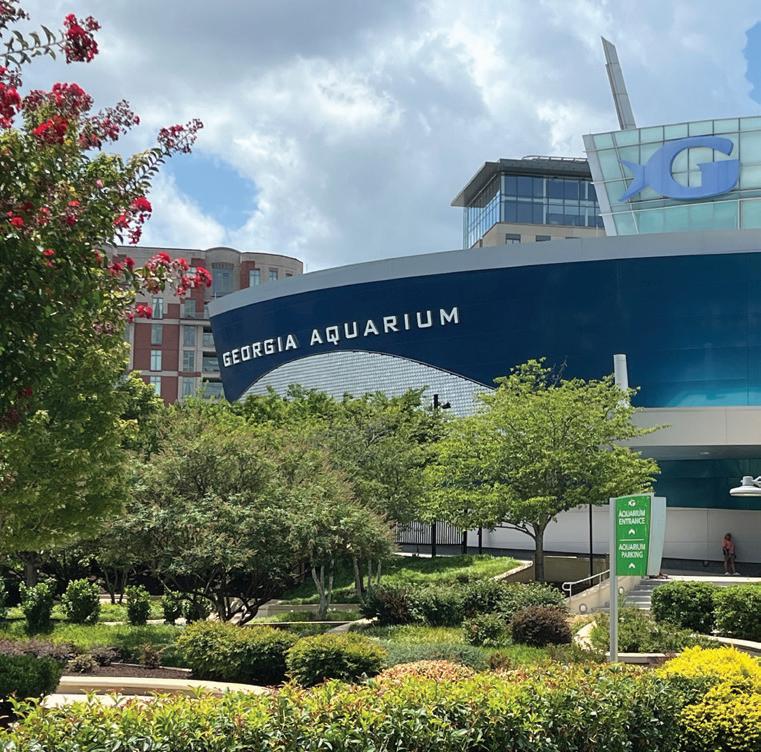

BY CYNTHIA BARNES
The only country in the world to occupy its own continent, Australia is one of the most fascinating and diverse — both environmentally and socially — nations on the planet. Isolated by a vast ocean and untouched by European explorers until the 1600s, it remains a relatively sparsely populated country of unparalleled contrasts and exceptional beauty. Its rich rainforests, harsh deserts and more than 500 national parks are home to animals found nowhere else in the world, including kangaroos, koalas and platypus. Containing 10% of the world’s biodiversity, Australia also has the largest coral reef on the planet, com-
prising almost 3,000 individual reefs and nearly 1,000 islands.
The heritage of Aboriginal Australians showcase one of the world’s oldest continuous cultures. British settlers (many of them convicts exiled as punishment) began arriving in 1788. Today nearly one quarter of the British commonwealth’s population were born elsewhere, giving cities like Melbourne, Sydney, and Brisbane an air of international excitement.
Whether seeking wilderness or worldclass arts cuisine, groups will find the “Land Down Under” truly worthy of its bucket-list status.

Boasting one of the world’s most recognizable skylines, cosmopolitan Sydney is the first stop for most travelers to Australia. The nation’s largest city offers a dazzling blend of nature, architecture and urban experiences in vibrant neighborhoods that range from trendy to historic. For an unforgettable experience, spend a few hours at the iconic Sydney Opera House before embarking on a guided climb of the Harbour Bridge for incomparable views of the city. Then relax on world-famous Bondi Beach, perfect for surfing, sunbathing or people-watching. Nature lovers won’t want to miss experiencing unique flora and fauna at the Royal Botanic Gardens and Taronga Zoo.

A massive red sandstone dome jutting more than 1,100 feet above the desert in the Red Center region of Australia, Uluru is a national icon with sacred meaning to the indigenous Anangu population. At the Uluru-Kata Tjuta Cultural Centre, visitors can gain insight into the geology and cosmology of the largest monolith in the world. While climbing Uluru (formerly known as Ayers Rock) is no longer allowed, the intrepid may explore the base, which is almost six miles in circumference. Sunrise and sunset are particularly spectacular, as the sandstone glows with vibrant shades of red and orange.
Whether scuba diving, snorkeling, or observing via helicopter, hot air balloon, seaplane or glass-bottom boat, visiting Australia’s Great Barrier Reef is a must. Stretching more than 1,400 miles along the continent’s eastern coastline, the reef boasts a rainbow of coral formations, more than 1,600 species of fish and six of the planet’s seven sea turtle species. For warm water and maximum visibility, May through October is the best time to visit, but visitors January through March will have the opportunity to observe sea turtles hatching before they make their voyage into the Coral Sea.
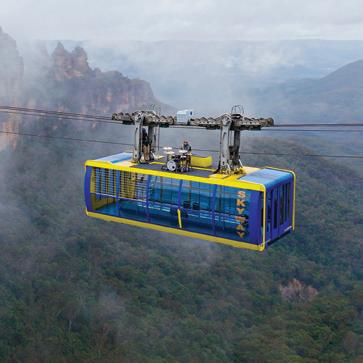
Australia’s Blue Mountains, a UNESCO World Heritage Site, has the world’s steepest railway, as well as raised boardwalks through rainforests, waterfalls, wineries, caves and much more. For an unforgettable experience, book a tour with an Indigenous guide who will share traditional stories and history. It’s an easy day trip from Sydney, but you’ll probably want to stay at least one night.

Australia introduced avocado toast and flat whites to the world, and their vibrant café culture is big on baked goods such as the Lamington. The traditional treat comprises a square of lighter-than-air vanilla sponge cake that is filled with cream and jam, then robed in chocolate icing and coated in dried coconut.

With penguin colonies, sea lions, spectacular rock formations, and of course, kangaroos, Kangaroo Island is one of the best nature destinations in the world. From five-star resorts to rustic camping, there’s an accommodation to fit every taste — even a lighthouse keeper’s cottage!
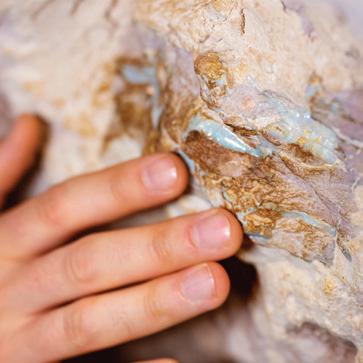

Ninety-five percent of the world’s opals originate in Australia. Aboriginal Dreamtime lore says the gems occurred when the colors of the rainbow touched the earth, and these sparkling beauties make a lovely souvenir. Not a jewelry person? Find a meaningful masterpiece from a First Nations artist or get a gorgeous pair of boots crafted from genuine kangaroo leather.

WITH ASHLEY RUNYON
Hosting a travel show to promote your tours is a great way to create a buzz and encourage travelers to book with you.
Whether in person or online, a travel show can spotlight the most exciting experiences of each of your tours and give travelers a preview of what’s to come. A travel show is a fun way to kick off your travel season and bring all your travelers and their friends into one venue for the night. They help you create excitement for the coming year and introduce members to your upcoming tours. And they give your travelers the opportunity to discuss tours with their friends or travel companions and decide what interests them. Often, travelers get excited about a tour by hearing about others’ interest in that tour.

If you are partnering with tour companies on your trips, invite them to the travel show. Many can send a representative to speak about your upcoming tours. Some representatives can offer door prizes or even provide goodies as extra incentives for people to book that night.
Your travel show is meant to be exciting and fun. As you plan your event, brainstorm with your team to think of new ideas to engage your travelers in a way that leaves them all impressed. Reach out to other travel planners or your vendor representatives to ask them for ideas on how to create an engaging atmosphere. If you get excited about your event, so will your travelers.
Here are some tips for planning successful travel shows.
A good rule of thumb when planning your travel show is to provide information about the trips you have planned for at least the next 12 months. Many program directors plan their travel shows for the fall or winter to highlight tours for the coming year. In my experience, Christmas travel shows have always been successful. Christmas brings excellent options for decorating and gift options.
As people arrive at your travel show, make sure to gather their information and have them pull up your Facebook page or other social media platforms and follow you. When they do so, enter their name into a drawing or credit them toward their next tour. Increasing your followers on social media with travelers who are genuinely interested in your tours is a great way to market upcoming tours. It will also allow potential travelers to see how much fun everyone has on your tours.
If your travel show is in person, print and have plenty of brochures for each tour. Whether it’s a tour you built yourself or
Ashley Runyon is a longtime bank and travel club planner. She lives in Ashland, Kentucky, with her family of six.
one you sell through a vendor, make sure travelers leave with plenty of information. During your presentation, PowerPoints and slideshows are a great way to dive deeper into what a tour looks like. Prepare a slide deck to promote your tours or ask a representative from one of your vendors to bring one.
Your travel shows should always be fun. Do giveaways, play games and offer handheld foods. It also helps to walk around, greet the attendees personally and encourage them to mingle with others. Make this an enjoyable event for everyone, with a set time for a short presentation that doesn’t go too long or take over the evening. Try setting tables around the room, each one with info on a different tour. Spread your giveaways throughout the night to encourage people to stay for the entire event.
Travel shows can supercharge the booking process, because the people who attend them are likely very interested in traveling with you. Make sure you give them an easy way to sign on the spot with a one-night-only discount. Giving early signup incentives is a great way to help travelers decide and commit. It also gives you a better understanding of your numbers for each tour and gives you plenty of time to market more or expand the tour’s capacity. If a tour sells out, it might indicate you should think about taking a second bus or offering a second date for the same tour.
Follow up with your travelers after the show. Thank everyone who attended the event. Email them each individually and provide links to your tour information and itineraries. If someone attended the event but didn’t sign up for a tour, try calling them and asking them if they had any questions about a specific trip. Some travelers just need a little extra attention and nudging to sign up. If you have yet to receive the number of signups you were hoping for, try extending the early signup incentive, but make sure you set a deadline. When you send the thank-you emails, make sure to tell people you’re extending the promotion window. Post pictures of the event on your social media account to create interest for those unable to attend.




